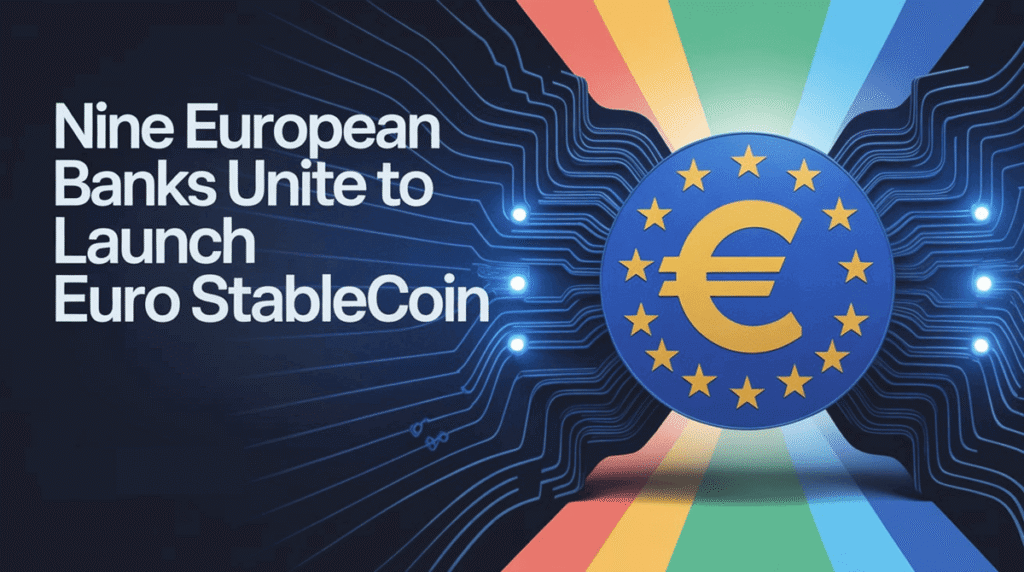Key Takeaway: Major European banks create consortium to launch MiCAR-compliant euro stablecoin by 2026, challenging US dollar dominance. Europe’s banking alliance to launch a euro stablecoin marks a landmark step toward digital payment sovereignty. By countering U.S. dominance, ensuring strict regulatory compliance, and leveraging blockchain efficiency, this initiative strengthens European financial autonomy, fosters innovation, and aligns with ECB goals, signaling a transformative era in global digital finance.

Banking Giants Form Unprecedented Alliance
Nine of Europe’s most prominent financial institutions announced Thursday their collaboration to establish a new company dedicated to launching a euro-denominated stablecoin, marking a pivotal moment in the continent’s push for digital payment sovereignty.
The consortium includes banking heavyweights ING, UniCredit, Banca Sella, KBC, Danske Bank, DekaBank, SEB, CaixaBank, and Raiffeisen Bank International, representing eight European countries and managing trillions of euros in combined assets.
Strategic Response to US Market Dominance
Addressing the Dollar Stablecoin Problem
Currently, 99% of all stablecoins are pegged to the US dollar, with market leaders Tether (USDT) and Circle (USDC) controlling approximately $171 billion and $60 billion respectively. This overwhelming American dominance has sparked concerns among European policymakers about monetary sovereignty and financial independence.
“We are contributing to fill the need for a trusted, regulated solution for on-chain payments and settlement, paving the way for a new standard in the digital asset space that will support Europe’s growth and financial sovereignty,” explained Fiona Melrose, UniCredit’s head of strategy.
European Financial Autonomy
The initiative represents what the banks call “a real European alternative to the US-dominated stablecoin market, contributing to Europe’s strategic autonomy in payments”. This aligns with broader European Central Bank concerns about foreign stablecoin influence potentially undermining monetary policy effectiveness.
Technical Framework and Compliance
Regulatory Foundation
The consortium has established a new company in the Netherlands, chosen for its favorable regulatory environment and the Dutch Central Bank’s financial supervision expertise. The entity will seek licensing as an e-money institution under Dutch Central Bank oversight, ensuring full European Union regulatory compliance.
The stablecoin will operate under the EU’s Markets in Crypto-Assets Regulation (MiCAR), which took effect in 2024. MiCAR mandates that stablecoin issuers maintain 1:1 reserve backing with liquid assets, provide transparent reporting, and submit to enhanced regulatory oversight for large-scale operations.
Advanced Digital Capabilities
“Digital payments are key for new euro-denominated payments and financial market infrastructure. They offer significant efficiency and transparency, thanks to blockchain technology’s programmability features and 24/7 instant cross-currency settlement,” stated Floris Lugt, ING’s Digital Assets lead.
The stablecoin will enable near-instant, low-cost payments with round-the-clock accessibility, supporting cross-border transactions, programmable payments, and enhanced supply chain management.
Launch Timeline and Operations
2026 Market Entry
The consortium expects to issue the stablecoin in the second half of 2026, following regulatory approvals and technical infrastructure completion. A CEO appointment is anticipated soon, subject to regulatory approval, while the consortium remains open to additional European banks joining.
Individual member banks will offer value-added services, including stablecoin wallet solutions and custody services, creating a comprehensive European digital payments ecosystem.
Latest Developments in European Digital Strategy
Parallel ECB Initiatives
This private sector initiative complements the European Central Bank’s ongoing Digital Euro project, which entered its preparation phase in November 2023. The ECB aims to launch a retail Central Bank Digital Currency by the late 2020s.
Recent ECB communications underscore the urgency of European digital payment solutions. In August 2025, ECB President Christine Lagarde urged European lawmakers to “seize the ‘euro moment'” and rapidly establish digital euro legislative frameworks, citing US stablecoin dominance concerns.
US Regulatory Developments
The timing coincides with significant US stablecoin regulation changes. The recently enacted GENIUS Act created a federal framework for stablecoin regulation, potentially accelerating US market growth while creating regulatory divergence with European approaches.
Historical Context and Banking Innovation
Learning from JPMorgan’s Success
The European initiative follows JPMorgan Chase’s precedent with JPM Coin, launched in 2019 as the first major US bank-issued stablecoin. JPM Coin processes over $1 billion daily and has handled approximately $1.5 trillion in total volume.
However, the European approach differs significantly. While JPM Coin operates on JPMorgan’s private blockchain primarily for institutional payments, the European stablecoin will use public blockchain infrastructure for broader market segments.
European Collaboration History
European banks have historically succeeded through collaboration, exemplified by the Single Euro Payments Area (SEPA) creation in 2008, which standardized euro payment processing across EU member states. This consortium model demonstrates institutional commitment to pan-European solutions.
The European Central Bank has researched central bank digital currencies since 2020, conducting extensive studies on distribution models and market impact. This research has informed both public CBDC development and private stablecoin frameworks.
Source: Information gathered from official announcements by ING, UniCredit, Reuters, and regulatory documentation from the European Central Bank and European Banking Authority.
